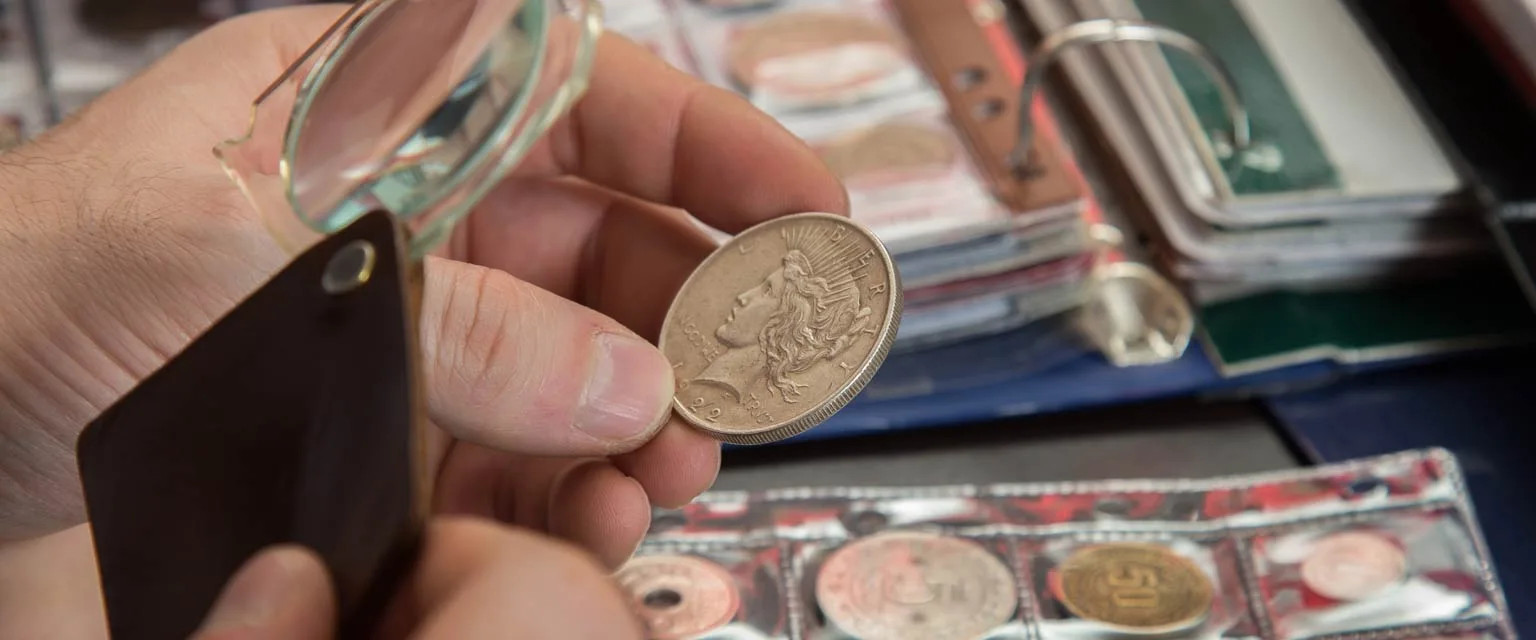You open a drawer, dig through a box in the garage, or inherit a small pouch from a relative, and inside are old coins. Maybe they look valuable. Maybe they’re just dusty. But one question instantly comes to mind: What is my coin worth?
The answer might surprise you. Some coins are worth only their face value—what’s printed on them. Others, however, may be worth far more due to rarity, condition, or metal content. Whether you’re holding a common wheat penny or a potential collector’s dream, it pays to know the difference.
In this beginner’s guide, we’ll walk you through how coin value is determined, what factors impact pricing, how to avoid common mistakes, and most importantly, how to get an accurate, trustworthy appraisal.
At CV Coins & Collectables, we’ve been helping people in San Diego County understand and evaluate their coins for over 50 years. Our goal is to help you identify whether you’re holding spare change or a small fortune.
Understanding Coin Value: It’s More Than Just the Date
When most people wonder, “What is my coin worth?” they tend to flip it over and look at the date. While the date can offer a helpful clue, it’s only one part of a much bigger picture. To truly understand a coin’s value, you need to look beyond the year it was minted.
There are three types of value to know:
- Face value: What the coin is officially worth as currency (for example, one cent or one dollar).
- Melt value: The value of the metal if the coin were melted down (this matters especially for silver and gold coins).
- Collector value: What buyers are willing to pay based on rarity, demand, and condition.
Five Key Factors That Determine a Coin’s Worth
1. Date and Mint Mark
Older coins generally carry more value, especially those minted in limited numbers. The mint mark tells you where the coin was produced (like “D” for Denver or “S” for San Francisco), and certain mint locations had lower production runs, making those coins more scarce.
2. Condition (Grading Basics)
Coin grading ranges from poor to mint state, with higher grades indicating coins that are well-preserved and less worn. A coin in “Good” condition might be worth a few dollars, while the same coin in “Mint State” could fetch hundreds.
3. Rarity and Scarcity
Even common-looking coins can be valuable if few were made or survived. For example, the 1909-S VDB Lincoln cent is highly sought after because of its low mintage.
4. Demand and Market Trends
Coins tied to key events or with unique features can rise in value due to increased interest. Market trends often shift based on collector preferences, economic conditions, and even pop culture.
5. Metal Content
Coins minted before certain dates may contain high amounts of precious metals. For instance, U.S. dimes, quarters, and half dollars minted before 1965 contain 90% silver, making their melt value significantly higher than face value.
Real-World Example
A 1964 Washington quarter has a face value of 25 cents. But because it contains 90% silver, its melt value often exceeds $6, depending on the market. In contrast, a 1990 quarter has no silver and is usually worth just 25 cents unless it’s in perfect condition or has a rare minting error.
Understanding these basics helps you get a clearer picture of your coin’s true value. Next, we’ll look at how to spot key collectible coins and avoid common pitfalls when evaluating your collection.
Common Types of Valuable Coins
Here are some of the most commonly collected, and occasionally very valuable, U.S. coins people bring in for appraisal:
Wheat Pennies (1909–1958)
These pennies feature two wheat stalks on the reverse and are among the most recognized collector coins. While most are worth just a few cents or dollars, rare varieties like the 1909-S VDB or the 1914-D can fetch hundreds, or even thousands, depending on condition. Start with dates 1931 and before. This will help identify better dated coins.
Buffalo Nickels (1913–1938)
Known for their rugged American imagery, Buffalo nickels are beloved by collectors. Coins from the early years or with clear dates (many are heavily worn) often carry added value. Start with coins dated before 1931. Just like pennies. This is where coins are starting to be worth more because of the scarcity. Condition means a lot!
Mercury Dimes (1916–1945)
Named for the winged Liberty head that resembles the Roman god Mercury, these 90% silver dimes can be valuable based on both silver content and rarity. The 1916-D is one of the rarest in the series. All dimes dated 1964 and before have silver. Mercury dimes are harder to find before 1921. The 1926 S mint also is a better date.
Pre-1965 Silver Coins
Dimes, quarters, and half dollars minted before 1965 contain 90% silver. Which make it more valuable than the face value on the coin.
Statehood Quarters (1999–2008)
Despite their popularity, most Statehood quarters are not rare unless there’s an error. Double strikes, missing designs, or off-center minting can significantly raise value.
Error Coins and Misprints
Coins with mistakes can be surprisingly valuable. Look for off-center strikes, doubled dies, missing features, or mismatched planchets. The novelty and rarity of errors make them hot items for collectors.
Knowing what to watch for can make the difference between spending a coin and saving a small treasure. In the next section, we’ll dive into how coin grading and condition can dramatically impact value.
How to Evaluate Coins at Home (Before Getting an Appraisal)
Before you bring your coins in for a professional appraisal, a simple at-home evaluation can help you get a better sense of what you have. You don’t need to be an expert to make a smart start. Just follow a few best practices to avoid damaging your coins and to keep things organized.
Step 1: Don’t Clean Your Coins
It’s tempting to polish an old coin to “make it look better,” but resist the urge. Cleaning can ruin the surface and significantly reduce value. Collectors and appraisers prefer coins in their original, unaltered state, even if they look dirty.
Step 2: Handle with Gloves
Skin oils can cause damage, especially to coins made from copper or silver. Use cotton gloves when handling coins, and always hold them by the edges, never the faces.
Step 3: Use a Magnifier and Good Lighting
A basic magnifying glass or loupe can help you spot important details like the mint mark, fine scratches, or any errors. Natural daylight or a bright LED desk lamp can help make subtle features stand out.
Step 4: Identify Key Details
Look at the date, mint mark (usually found near the date), and visible wear. These three factors can give you an initial sense of rarity and condition. Coins with clear dates and minimal wear are generally worth more.
Step 5: Use Reference Tools
Invest in a “Red Book” (The Official Red Book: A Guide Book of United States Coins) or browse reliable online price guides and coin apps. These tools can help you identify coins and estimate their value ranges.
Step 6: Organize Your Coins
Sort coins by type—pennies, nickels, dimes, etc.—and within each group, organize by date and condition. Keeping your collection tidy will make the appraisal process faster and more accurate.
Next, we’ll look at how the professional appraisal process works and what you should expect when bringing in your coins.
What to Expect From a Professional Coin Appraisal
A coin appraisal is more than just someone giving you a number. It’s a detailed process that helps you understand your coin’s true value based on current market conditions, physical condition, rarity, and demand.
What Does a Coin Appraisal Include?
A proper appraisal evaluates several factors:
- Authenticity: Verifying whether the coin is genuine.
- Date and mint mark: These often determine the coin’s rarity.
- Condition: Using grading standards from Poor to Mint State.
- Market value: An estimate based on recent sales and current demand.
Good appraisers will also take the time to explain how they arrived at their evaluation, rather than just quoting a price with no context.
When Should You Get a Coin Appraised?
There are several situations when an appraisal makes sense:
- Inheritance or estate planning: If you’ve received a collection or are planning to pass one down.
- Insurance purposes: To ensure valuable coins are properly covered.
- Before selling: To understand what your coin is worth and avoid undervaluing it.
- Out of curiosity: Even if you’re not planning to sell, knowing the value of your collection is rewarding and informative.
Red Flags to Watch Out For
Not all appraisers are created equal. Avoid anyone who:
- Won’t let you watch the appraisal
- Pressures you to sell immediately
- Refuses to explain how values are determined
A reputable appraiser should be transparent, experienced, and happy to answer your questions.
Free vs. Paid Appraisals
Some dealers offer free verbal appraisals, especially if you’re considering selling to them. Written appraisals for legal or insurance purposes come with a fee. Be sure to clarify what kind of appraisal you need before booking.
At CV Coins & Collectables, we offer both in-store and virtual appraisals. Whether you’re local to San Diego County or located elsewhere, we make it easy to get expert guidance from a team known for honesty, transparency, and top-dollar payouts.
Mistakes to Avoid When Trying to Find Out What Your Coin Is Worth
When people discover an old coin, it’s natural to get excited. But rushing to determine its value or acting on bad advice can lead to costly mistakes. Here are the most common errors beginners should avoid.
1. Cleaning Your Coins
It might seem like a good idea to polish up an old coin to make it shine, but this can significantly reduce its value. Collectors often prefer coins in their natural, unaltered state — even with tarnish or dirt — because cleaning can scratch or damage the surface and erase key details used in grading.
2. Trusting Internet Myths or Viral TikToks
The internet is full of misinformation. Not every coin with a strange marking or odd date is rare. TikTok and YouTube videos sometimes exaggerate values or misidentify coins entirely. Always cross-check with reliable sources.
3. Relying Only on Melt Value
The melt value reflects only the raw metal worth of your coin, based on its gold, silver, or copper content. While this is useful for bullion coins, it ignores historical, cultural, and numismatic factors that can make a coin much more valuable.
4. Selling to “We Buy Gold” Kiosks Without Research
Many kiosks or pop-up buyers offer convenience, but not always fairness. Without a full understanding of your coin’s potential worth, you risk underselling. Do your homework or consult a reputable dealer before accepting any offer.
5. Using Outdated or Unofficial Price Guides
Coin values change over time. If you’re referencing a price guide from 10 years ago or using an unreliable online source, you may be getting inaccurate information. Use current, verified guides or consult with a professional appraiser.
How to Sell or Keep Your Coins: What to Do Next
Once you understand what your coin is worth, the next step is deciding what to do with it. This choice isn’t always just about money. For many people, coins carry emotional significance—maybe they were inherited from a loved one or collected during childhood. That sentimental value is important to consider before making any decisions.
Should You Sell or Hold?
Selling your coin can provide quick cash, especially if it has significant market value. But holding onto rare or promising coins might be a smart move if you think the value will increase over time. It can also be a meaningful way to preserve family history.
If you decide to sell, weigh your options carefully:
Where to Sell Your Coins
- Local coin dealers – This is often the most straightforward and secure option. Dealers like CV Coins & Collectables offer face-to-face service, honest appraisals, and immediate payouts.
- Coin shows – These events allow you to meet multiple buyers and collectors in one place. You might get competitive offers, but you’ll need to know your coin’s worth beforehand.
- Online platforms – Websites like eBay or coin forums can work, but they come with risks like scams, shipping issues, and price haggling. Know your buyer and set a clear return policy.
Don’t Forget Documentation
Grading, certificates, and proper storage all boost your coin’s credibility and value. If you plan to sell high-value pieces, professional grading is often worth the investment.
Final Thoughts: Every Coin Has a Story—and Some Are Worth More Than You Think
Whether it’s tucked away in an old drawer or handed down through generations, every coin has a history, and some have surprising value. But understanding what your coin is truly worth takes more than a quick internet search.
That’s where CV Coins & Collectables comes in.
For over 50 years, we’ve been San Diego County’s most trusted name in coin, currency, and collectible appraisals. People travel from all over to visit our shop because they know we’re honest, transparent, and above all else, fair.
We make the process simple:
- Schedule an in-store appointment or call us at (619) 427-9154 to get started.
- We evaluate your coin’s true value, using current market data — no guesswork, no pressure.
- Get paid top dollar, cash for your items.
We specialize in U.S. and international coins, precious metals, paper currency, jewelry, and collectibles. Whether you’re ready to sell or just want to know what your coin might be worth, our expert team is here to help, and we’ll treat your collection with the respect it deserves.
Please visit our resource page where we have identified many key dated coins we are looking for. These identified coins we are willing to pay extra money. We show many key dated coins we are looking for!
Don’t let your coins collect dust. Let’s find out what they’re really worth together.



